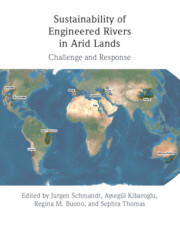Book contents
- Sustainability of Engineered Rivers in Arid Lands
- Sustainability of Engineered Rivers in Arid Lands
- Copyright page
- Dedication
- Contents
- Contributors
- Part I Introduction
- Part II Challenge
- 2 Global Climate Change and the Rivers
- 3 Reservoirs
- 4 Depletion of Groundwater
- 5 Endangered Food Security
- 6 Declining Environmental Flows
- Part III Engineered Rivers
- Part IV Response
- Part V Conclusion
- Index
- References
2 - Global Climate Change and the Rivers
from Part II - Challenge
Published online by Cambridge University Press: 16 September 2021
- Sustainability of Engineered Rivers in Arid Lands
- Sustainability of Engineered Rivers in Arid Lands
- Copyright page
- Dedication
- Contents
- Contributors
- Part I Introduction
- Part II Challenge
- 2 Global Climate Change and the Rivers
- 3 Reservoirs
- 4 Depletion of Groundwater
- 5 Endangered Food Security
- 6 Declining Environmental Flows
- Part III Engineered Rivers
- Part IV Response
- Part V Conclusion
- Index
- References
Summary
Currently available climate models predict the planet will be warmer at the end of this century by about 3C plus/minus 1.50C, while certain regions (the polar regions and the interiors of larger landmasses) will warm slightly more and ocean surfaces will warm at a slower pace. Climate modeling also tells us that the midlatitude storm belts will recede gradually toward their respective poles, causing the Hadley Cells to widen and expanding the arid subtropical zones. Warming in the cloud-free subtropics will lead to more warming and hence more evaporation of soil water. This chapter presents a thorough and accessible discussion of climate modeling to estimate future conditions in the Earth-hydrological system. It analyzes patterns of rainfall, potential evapotranspiration, actual evaporation, and runoff, among other factors, as well as the feedback mechanisms in the climate system that will impact water availability and use in the SERIDAS basins.
Keywords
- Type
- Chapter
- Information
- Sustainability of Engineered Rivers In Arid LandsChallenge and Response, pp. 13 - 30Publisher: Cambridge University PressPrint publication year: 2021



